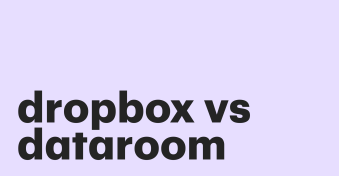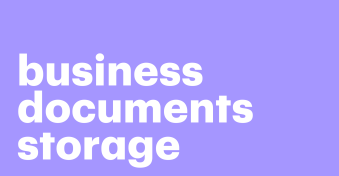If you’re new to virtual data rooms (VDRs), there’s a chance you have questions.
And guess what? We’ve got answers.
VDRs, also referred to as deal rooms or electronic data rooms, take a bit of getting used to – but they are excellent investments for companies of any size —and we’re here to guide you through finding one that meets your needs.
According to Morgan Stanley, the number of mergers and acquisitions (M&A) could rise by as much as 50% in 2024,1 after the lowest activity in almost two decades in 2023.
With more deals comes a need to get things done, well…better.
What is a virtual data room?
A virtual data room (VDR) is a secure, centralized hub where parties from all sides can organize and share resources, collaborate, negotiate, and track documents.
What is the purpose of a virtual data room?
- In sales, deals, mergers, and acquisitions, VDRs streamline due diligence processes, enabling stakeholders to share, review, and negotiate contracts, NDAs, and financial statements with precision and efficiency. Sales teams can use them to utilize various media formats for selling (videos, presentations, etc.) and consolidate all complex deal data in one location to maximize deal flow automation.
- Legal professionals rely on VDRs to manage case files, maintain client confidentiality, and ensure compliance with stringent regulations.
- Healthcare organizations leverage VDRs to safeguard electronic health records (EHRs) and medical research data, fostering collaboration among healthcare professionals while maintaining strict privacy standards.
- In private equity, VDRs facilitate due diligence, portfolio management, and investor communications, ensuring transparency and trust among stakeholders.
- For tech companies managing intellectual property (IP) and complex licensing agreements, VDRs provide a secure environment to safeguard proprietary technology documentation and foster innovation through streamlined collaboration among cross-functional teams.
What are the best virtual data room providers?
Let’s now explore the market-leading data room providers, together with their features and support options to identify the best VDR providers for your business’s data needs:
1. PandaDoc
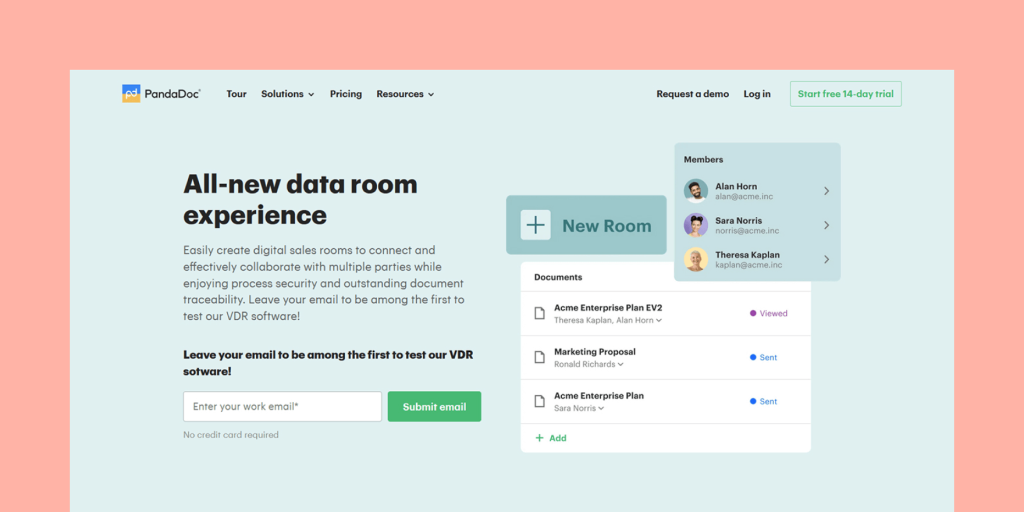
PandaDoc Rooms makes it easy to share your business virtual data room with team members via direct link or email.
Choose from varied document customization options to ensure your information is only seen by authorized members.
An intuitive and guided signing experience guarantees that no one skips important document signatures, and you’ll be informed of any document changes in your virtual data room immediately.
PandaDoc Rooms delivers a new method of collaboration on complex multi-document deals with any number of participants.
Key features:
- Alerts/notifications
- Archiving & retention
- Audit trail
- Collaboration tools
- Compliance tracking
- Customizable templates
- Document classification
- Document generation
- Drag & drop editor
- Electronic signature
- File conversion
- Search/filter
- Third-party integrations—Slack, Salesforce, Zoom, Google Workspace, Canva, Pipedrive, Zoho, Google Docs, and many more
- Version control
- Workflow management.
A full suite of support is available, including:
- Email/help desk
- FAQs/forum
- Knowledge base
- Phone support
- 24/7 (live rep)
- Chat
Thanks to PandaDoc, you can:
- Share documents with relevant recipients with a few clicks
- Easily provide prospect content
- Conveniently define data access levels
- Minimize processing delays and editing conflicts.
With PandaDoc Rooms, you can use VDR as sales rooms to share documents, collaborate with buyers, and automate your sales cycle from end-to-end.
This means that you can start selling even before the first call!
Use the intuitive sales workflows to guide a client through your promotional materials, request data from prospects, and collect and store data related to the same business transaction in a single space.
PandaDoc empowers you to share data in any format, including video, presentation, sheets, or docs, so you can share the precise content you need for the best impression.
Set up and manage visibility permissions for each document to ensure the right people see the right things.
2. iDeals
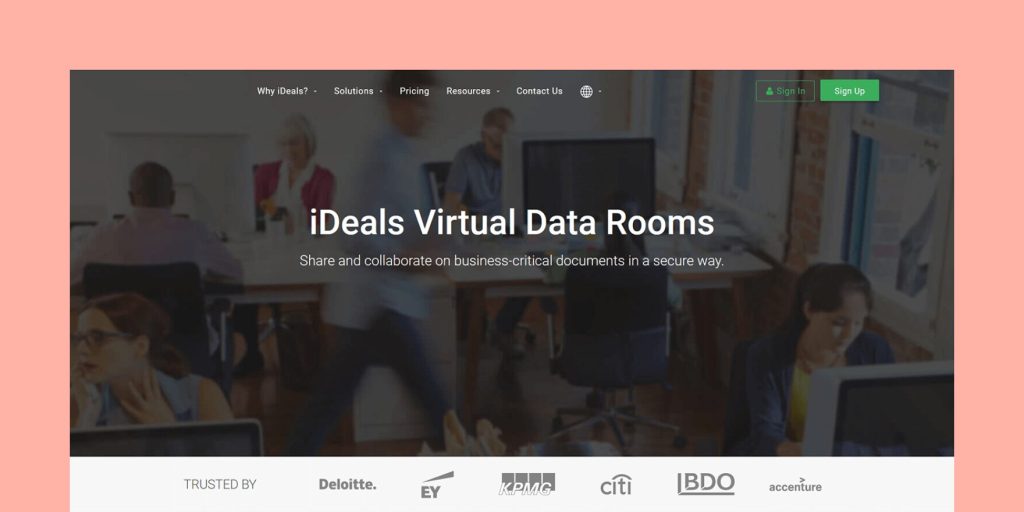
iDeals allow you to upload business files in 25+ different formats, making it simple to get the information into your virtual data room without extra preparation and fuss.
Compared to PandaDoc, the standard workflows integrated with iDeals don’t offer as much flexibility for project management purposes.
Optical character recognition and full text search features track down the information you want using multiple search filters.
iDeals enables the upload, deletion, merging, moving, viewing, downloading, restoring, and renaming of your files and folders easily, plus you can merge the content of several files into a single PDF file.
Key features:
- Audit trails
- Built-in redaction
- Customizable dynamic watermarks
- Custom terms of access / NDA
- Custom branding
- Drag-and-drop file upload
- Notes and comments
- Optical character recognition
- Scheduled reports via email
- Screenshot prevention
- Standard Q&A management process
- Standard workflows
- Two-factor authentication
- Two hardware-encrypted USB drives with data room archive
Support:
- 24/7 multilingual support via email, chat, and phone. Extended premier support is available on the Business plan.
3. Datasite
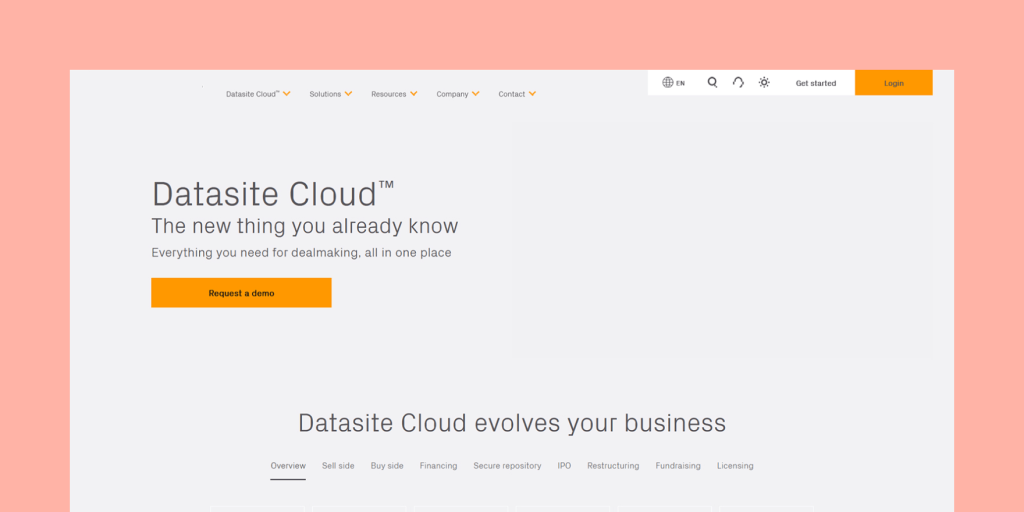
Datasite is a secure web-based app that operates on Mac or Windows systems.
There’s also a Datasite mobile app that you can use to manage your data on an iOS or Android device.
However, the complex interface in contrast to PandaDoc’s user-friendly platform might pose a problem for some less technical users.
One key feature of Datasite’s solution is AI redaction, allowing you to easily and confidently manage your redactions by finding instances of specific words across the virtual data room.
Key features:
- AI redaction
- Analytics
- Content categorization
- Customizable watermarking
- Data encryption at transit and at rest
- Email file upload
- Granular permissions management
- Integrated Q&A
- Multilingual search
- Two-factor and multi-factor authentication
Support:
- Phone support landlines are available for the United States, Canada, Latin America, EMEA, and APAC countries.
- Live chat support is available, together with demo videos, live training classes, and customer forums.
4. Digify
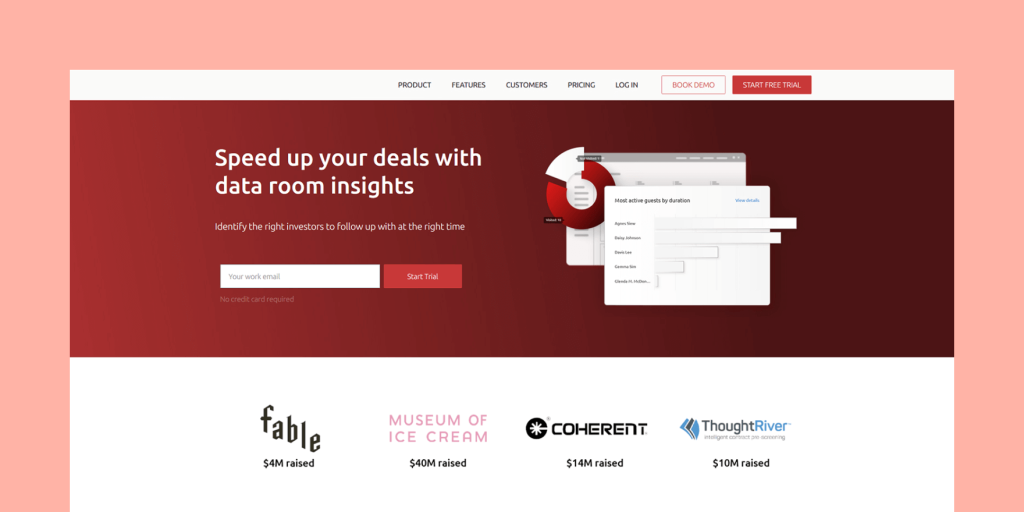
Digify is cloud-based software that provides oversight, protection, and tracking of your business documents.
You get some third-party integrations but not the full suite with some virtual data room solutions — for instance, PandaDoc offers 30+ business application integrations.
This all-in-one solution integrates document access control, advanced encryption, print and download permissions, and customizable watermarks to give you and your team control over your sensitive data.
Key features:
- Brand colors and logos
- Data room groups
- Folder-level granular permissions
- One-click NDA/terms of access
- Real-time notifications
- Team-wide file statistics
- Third party integrations—Dropbox, Box, Google Drive
- Unlimited data rooms with one account
Support
- Email and chat support is available on the Pro plan
- With the Team plan you get additional phone support
5. DealRoom
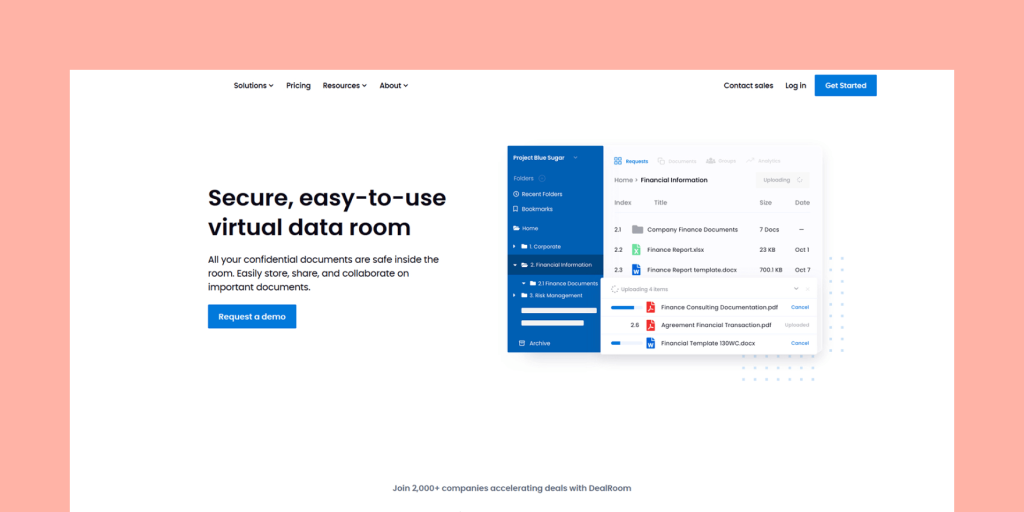
DealRoom provides a solution for businesses of all sizes to securely store and share sensitive information with interested parties.
All your business data is encrypted with 256-bit AES encryption to stop hackers from accessing your documents.
Cloud backups keep your data safe in the event of system failures or network crashes.
Key features:
- Access permissions
- Alerts/notifications
- Audit log
- Built-in Excel and document viewer
- Dynamic or fixed watermarks
- File expiration tool
- Full text search
- One-click NDAs
- Multi-factor authentication
- Recovery capability
- Reporting and analytics
- Screen Shield
- SSL security
- Third party integrations—Google Drive, Box, Gmail, Outlook
Support:
- 24/7 support via email, helpdesk, phone support, and chat.
How do I create a secure data room?
How it works:
- Create and publish your room: Gather all your proposals, contracts, presentations, and other relevant files in a PandaDoc Room. Set visibility permissions to ensure the right content is marked “visible to all Room members.”
- Generate your link: Once the Room is ready, publish it and generate a unique Room Sharing link.
- Share the link: Send the link to your client via email, chat, or share it through any communication channel you prefer.
- When clients open the Room via the shared link, they’ll enter a preview mode. This allows them to see content marked as “visible to all Room members.”
- To perform actions (like signing a document) or view restricted content, users will need to verify their access through their email.
See how it looks! Check out this virtual room:
Benefits of a virtual deal room
Unified workspace
Consolidate all documents, materials, and communications in a shared space, accessible anytime, anywhere.
Share any content you need
Effortlessly share various content types, from videos and presentations to sheets and docs – we’ve got you covered!
Automated workflows
Eliminate manual document sending to save time and keep your work moving forward seamlessly.
Personalized branding
Enhance your professional image with custom branding, incorporating your company logo and identity for a cohesive user experience.
How much does a virtual data room cost?
Some VDR providers offer pricing based on usage, such as per-page or per-user pricing, which can be more cost-effective for businesses with sporadic or occasional data room needs.
For example, here’s how PandaDoc’s pricing works.
If you sign up for a Business plan ($49/month), you receive access to 3 Rooms – all workspaces combined, after which you have to upgrade to Enterprise.
If you’re signed up as a PandaDoc Enterprise client, you enjoy access to unlimited rooms.
For a detailed breakdown on virtual data room pricing, read more.
Are virtual data rooms the answer?
In a paper published by the Institute of Mergers, Acquisitions and Alliances (MANDA) paper, researchers explored the value that virtual data rooms (VDRs) bring to the mergers and acquisitions (M&A) process.
It investigates how VDRs enhance efficiency, security, and collaboration in due diligence activities, deal negotiations, and post-merger integration.
Through case studies and empirical analysis, the authors demonstrate the tangible benefits of VDRs in facilitating smoother transactions, reducing costs, and improving deal outcomes for both buyers and sellers in M&A deals.2
Because everything feels less intimidating when you take it one step at a time (including adopting a VDR for your business), we’ve organized all of these common virtual room software questions so you can quickly find what you need.
From pricing considerations to scalability and functionality, this guide will equip you with the knowledge to choose the best VDR for your business needs, including user activity tracking, secure document sharing, NDAs, mobile app integration, messaging features, and adherence to ISO 27001 standards.
Keep reading for our tips—and bookmark this page for later.
Get excited—here’s where it all begins.
If you’re just getting started and have some questions about cloud-based VDR providers, let us take it from here.
How to find the virtual data room to meet your needs
Selecting the right data room software for your business is a crucial decision that can significantly impact your operations and data security.
Make sure you evaluate what a data room offers before you invest resources, time, and energy into a new software.
Compare features
Create a checklist of features and functionalities that are important to your business, like ensuring that sensitive data is protected.
Compare different data room software options based on criteria such as:
- Security features
- Secure file sharing
- Usability
- Document management capabilities
- User interface
- Customization options
- Pricing plans
- Notifications
- Activity tracking
- Advanced search
- Full text search
Evaluate security
Data security is paramount when selecting a virtual data room solution.
Assess the security measures implemented by each vendor, including:
- Encryption protocols
- Access controls
- Audit trails
- Two-factor authentication
- Compliance certifications (such as GDPR or SOC 2)
Consider ease of use
User experience plays a significant role in the adoption and success of data room software.
Choose a solution that offers an intuitive interface and user-friendly navigation to streamline collaboration and document management processes.
Look for features such as drag-and-drop functionality, search capabilities, and customizable workspaces.
Request demos and trials
Before making a final decision, request demos or trial periods from your shortlisted vendors.
This will allow you to experience the software firsthand and assess its suitability for your business needs.
Take advantage of this opportunity to ask questions, test key features, and solicit feedback from stakeholders.
Unlock a new way of working on multi-document deals
Before you make a decision on your virtual data room provider, ensure you do your own due diligence and evaluate your team’s feature requirements, integrations, and user experience.
By doing so, you will be able to assess each VDR provider objectively, making it easier to find the ideal solution.
Before finalizing your decision, don’t hesitate to compare multiple options by trying their demos.
Most of the virtual data rooms we’ve covered in this article offer a free trial so you can test them to see what you think.
Create your virtual data rooms with a solution like PandaDoc and you’ll not only gain complete control of your business’s information, but you can also explore a variety of additional document services like eSigning products, contract management tools, and document automation.
Frequently asked questions
-
To streamline document management, facilitate collaboration among stakeholders, and enable efficient communication, making them essential tools for conducting secure and organized business transactions.
-
Yes, VDRs are often deemed more secure than physical documents since you can assign viewing and signing permissions, document tracking, audit trails, and eliminate the risk of loss during transit.
-
Virtual data rooms have a number of use cases – from M&A to HR/onboarding to legal and sales. Imagine a secure virtual repository where parties can share documents, and collaborate with enhanced security, permissions, and encryption. It’s like a document nightclub, but you choose the guestlist.
-
Data room pricing varies depending on provider. For example, PandaDoc data rooms cost $49 USD per seat cost per month – which is up to 60% cheaper than other providers and provides a cost-effective alternative to in-person meetings and paper documents.
Disclaimer
PandaDoc is not a law firm, or a substitute for an attorney or law firm. This page is not intended to and does not provide legal advice. Should you have legal questions on the validity of e-signatures or digital signatures and the enforceability thereof, please consult with an attorney or law firm. Use of PandaDocs services are governed by our Terms of Use and Privacy Policy.
Originally published May 12, 2023, updated June 21, 2023
- Morgan Stanley, Why 2024 Could Be a Hot Year for M&A Show in the article ↑
-
Institute of Mergers, Acquisitions and Alliances (MANDA), ‘DO VIRTUAL DATA ROOMS ADD
VALUE TO THE MERGERS AND ACQUISITIONS PROCESS?‘ Show in the article ↑

